RISK BASED APPROACH FOR HAZARD DETECTION: Fire and Gas Detection Deployment and Placement Criteria
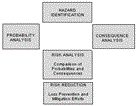
RISK-BASED ASSESSMENT
HAZARD IDENTIFICATION
CONSEQUENCE ANALYSIS
PROBABILITY ANALYSIS
RISK ANALYSIS
The best protection for risk reduction of hazardous chemical releases is through inherently safer designs and loss prevention initiatives. However, since complete risk reduction is not always practical or economically feasible, safety system designs must address the mitigation of hazardous release exposures. Hazardous exposure risks can be reduced through proper interface of process safety and hazard detection systems.
The same technology that is used to assess and control risk for process safety systems can be employed to design detection and alarm systems more effectively. The risk-based approach for hazard detection allows for determination of risk categories through traditional assessment techniquesi. Comparison of the likelihood versus the consequence is an excellent measure of risk, and can be used as a basis for hazard detector location.
Effective hazard detector location involves the proper deployment and placement of adequate and reliable detectors. The best deployment is provided by locating detectors in areas of the highest probability of accidental hydrocarbon release and of the highest potential for loss. The best placement is provided by positioning detectors to allow for prompt detection at incipient alarm levels. Using only laboratory tested and approved systems ensures reliability.
The ultimate goal or the Risk-Based (RB) assessment is that of loss prevention by reducing the probability of a release and mitigation of the extent of hazardous exposure. Reduction in release probability can be achieved through improved safety integrity levels, which effectively reduce the probability of major losses. Reduction in the extent of release can be accomplished by interfacing detection systems with safety systems for prompt alarm, shutdown, and depressurization. Reduction in the consequence of an ignited release can be achieved by providing prompt fire suppression.
To focus the RB assessment, the study area should be divided into nodes of controllable size. Each node should be a logical part of the process system that can be control by shutdown and/or blowdown protection. The smallest node could be a single process component, such as a compressor or pump, or may be a system of major components, such as a vessel with its associated instruments, valves, flanges, and pipework.
The RB assessment study must start with the following hazard identification components:
- Systematic review and understanding of the process system and chemicals involved.
- Physical attributes of containment, control, and instrumentation.
- Gas or vapor dispersion and effects of ambient conditions.
- Physical environment, and surrounding external components.
- Mass flow rate of a flammable release, probability of ignition, and the associated loss potential.
RB assessment key elements consist of hazard identification, probability analysis, and severity analysis. Hazard identification is the process of evaluating the elements of the system under consideration. Once the hazard is identified, the probability of threats producing a failure and chemical release can be evaluated by a simplified fault analysis. The severity of the release can be evaluated by a simplified event analysis. Probabilities and severities can also be evaluated by qualitative means depending on the experience of the assessors. Hazard detection can then be evaluated based on the degree and likelihood of serious exposure.
To ensure the success of the hazard assessment, the program must be well organized, thorough, credible, and must meet all concerns of the study objective, (detector deployment and placement). The following study structure is provided for establishing a format for either quantitative or qualitative procedure or a combination of assessment activities.
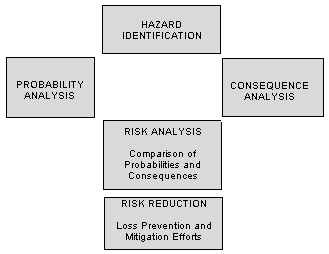
HAZARD IDENTIFICATION
Hazard identification (Hazid) activity involves the delineation and characterization of each potential release in sufficient detail to formulate potential accident scenarios and consequences. Each hazard scenario should be documented on a Hazid Data Sheet that includes the following information as a minimum:
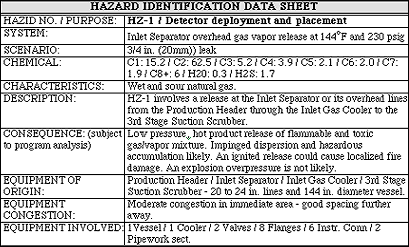
Identification of credible hazards is based on the evaluation of potential product releases from mechanical failures or human element accidents normal to the equipment involved, which could occur in the effective equipment life. Failure scenarios arise from elements of process systems including equipment, pipework, valves, flanges, and instrument connections. Each piece of equipment or process system must be set up in nodes and evaluated separately for review of hazardous consequences.
Unlike hazard consequence analysis, which must consider large leaks for their destructive impact, the smallest leak that could cause significant exposure should be evaluated for detector location. The size of the leak evaluated determines the sensitivity of the detection system to a large degree, and exemplifies the need for proper and adequate detector deployment and placement.
CONSEQUENCE ANALYSIS
Consequence analysis is based on hydrocarbon releases to the environment, which have the potential of damaging exposures from either volatile or toxic chemicals. For the purpose of hazard detection assessment, size and extent of the chemical dispersion should be quantified in terms of mass release rate and LEL or toxic PPM concentration. Consequence modeling should be provided for evaluation of impinged dispersion unless free jet dispersion is justified.
The consequence model should take into account conditions as determined through hazard identification review for a realistic and consistent methodology of analysis. Consideration must be given to the following release attributes:
- Direction of release
- Free jet consequence
- Diffused jet consequence
- Mist, two-phase flow, or rain-out conditions
- Equipment congestion
- Ambient conditions
- Topography
For establishment of categories for an order-of-magnitude rank of hazardous consequences, the following ranking method is proposed for either quantitative or qualitative evaluation: (The following severity categories are recommendations subject to the study objective and acceptance.)
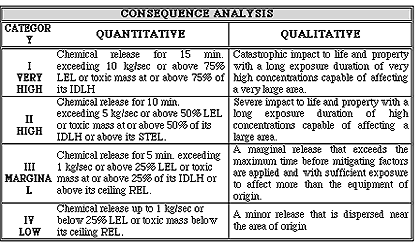
NFPA and API classify 25% LEL exposure as the threshold for safe air and consider electrical area classification requirements based on that conservative levelii. Gas detection of combustible releases should consider placement of sensors between safe and combustible concentration limits. Based on dispersion modeling and depending on physical conditions, combustible gas sensors should be deployed for prompt detection at 25% to 100% LEL dispersion concentrations.
NIOSH and OSHA establish exposure limits for toxic gas for both short and long term exposure on time-weighted averages (TWA) and ceiling exposure levels (CEL). Based on the most stringent established ceiling value, which should not be exceeded at any time, the upper recommended exposure limit (REL) for detection should be established. Where REL may be difficult to detect, the short-term exposure limit (STEL), which is a 15-minute TWA, should be used. Gas detection of toxic releases should consider placement of sensors between the REL and the level considered as immediately dangerous to life or health concentrations (IDLHs).
A traditional Probability Analysis can be based on conventional fault tree and event tree assessment methods modified for the review objective. A fault tree can consist of a release probability of the hazard scenario to predict the likelihood of the top event release incident. An event tree can begin with the top event or can be derived from release historical data base frequenciesiii.
The event tree assessment considers the frequency of the accident data for the equipment combined with the probability of the system components. Frequency data of wind and direction of release should also be inputted for a greater degree of assessment.
Leak frequencies can be prioritized on a rating category of A to E, with A being the most probable and E being the least. The following likelihood categories are proposed for either quantitative or qualitative evaluation: (The following probability categories are recommendations subject to the study objective and acceptance.)

DETECTION ASSESSMENT AND RISK ANALYSIS
Risk Analysis is a screening tool for evaluating the severity versus the probability of identification hazards. Each hazard scenario should be evaluated based on a risk-ranking method as demonstrated in the Risk Analysis Screening Matrix. Based on this style of matrix, the best risk ranking would have a category of IV-E and a ranking of 1 while the worst would have a category of I-A and a rank of 5, designated as "I-A-5".
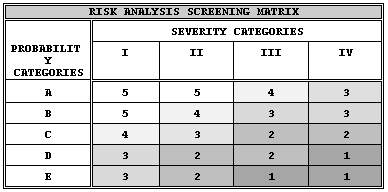
To best use the matrix as an engineering tool for detector location, the facility under evaluation should be divided into grids with overlay of dispersion models on the plot plan to address the risk in each grid. The grids should be sized with respect to the equipment spacing, e.g., high congestion should use small grids. A highly congested plant should have grids starting at 5-meter spacing, while open plant grids should be a 10-meter square. The grids should be tiered depending on the type of facility involved, e.g., a process structure may have multi-level grid arrangements. Depending on facility complexity, more than one size of grids and height of grid could be considered.
The risk grids are used as a means to record and compare risk levels of the risk analysis and to map the areas of greatest risk. A data base of risk grids cross referenced to the hazard scenarios should provide a means to review areas that have double or triple risk threats due to multiply hazards, which may change the focus of detector location to a cost benefit criteria employing less but more effective detection. Multiple overlapping of vapor hazard scenarios may also be used in assessment of the need for beam-type gas detection.
Multiple overlapping of risk levels can be recorded on the risk grids and summed to provide a relative risk for each grid. The higher the relative risks the greater the need for detection. Patterns of high-risk grids can indicate a trend and specific pattern for detector placement, and may provide justification for a cost benefit allocation of detectors.
i API RP 580, Risk-Based Inspection
ii NFPA 497A and API 500, Electrical Equipment Hazard Area Classification
iii E&P Forum (1992), Exploration and Production Data Collection on Hydrocarbon Leaks
About the author: Kerry Ridgway has over 25 years of experience in process safety consulting and engineering including; process safety management; fire and explosion assessments and evaluation of all types; and project management and related engineering disciplines. He holds a B.S. in Engineering from California State University, and is a registered professional engineer (P.E.) in Texas and as Fire Protection Engineering (FPE) in Florida. He is currently affiliated with ProTech Engineering, Houston, TX.
